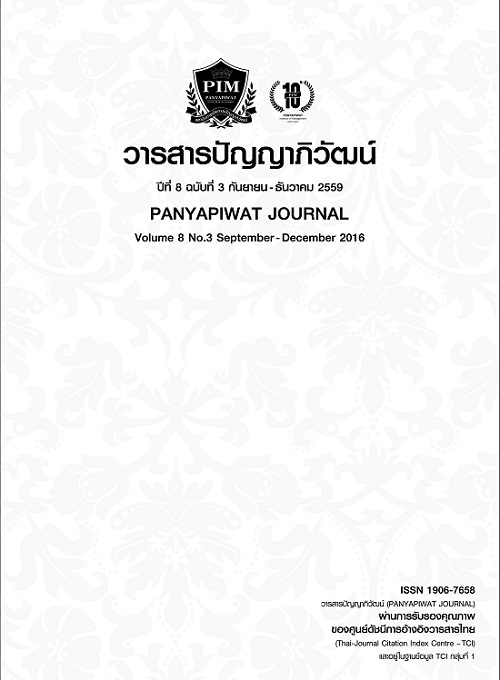การประเมินความพร้อมระบบบริหารทรัพยากรมนุษย์ภาคธุรกิจไทย
Main Article Content
บทคัดย่อ
การวิจัยนี้เป็นการวิจัยเชิงปริมาณ เพื่อพัฒนาแบบประเมินและทำการประเมินความพร้อมของระบบบริหารทรัพยากรมนุษย์ภาคธุรกิจไทย ในการพัฒนาแบบประเมินได้ใช้วิธีการให้ผู้ทรงคุณวุฒิตรวจสอบรายการที่กำหนดขึ้นร่วมกับการประชุมกลุ่มย่อย เครื่องมือที่พัฒนาขึ้นมี 11 ด้าน (รวม 72 ข้อ) เมื่อนำไปใช้ประเมินกับองค์กรภาคธุรกิจไทย จำนวน 211 องค์กร ได้ผลดังนี้คือ ด้านกลยุทธ์การบริหารทรัพยากรมนุษย์ มีค่าระดับความพร้อม (Readiness score) 44.52% ด้านองค์การประสิทธิภาพสูงและพัฒนาองค์การ มีค่าระดับความพร้อม 45.66% ด้านการกำหนดงานและสมรรถนะ มีค่าระดับความพร้อม 38.77% ด้านการบริหารผลงานเชิงกลยุทธ์ มีค่าระดับความพร้อม 43.11% ด้านการวางแผนกำลังคนและการสรรหาคัดเลือก มีค่าระดับความพร้อม 34.56% ด้านการเรียนรู้และพัฒนา มีค่าระดับความพร้อม 38.34% ด้านการบริหารความก้าวหน้าในอาชีพและผู้มีความสามารถสูง มีค่าระดับความพร้อม 32.90% ด้านการบริหารค่าตอบแทน มีค่าระดับความพร้อม 47.76% ด้านการจัดระบบงานและระบบสารสนเทศด้านทรัพยากรมนุษย์ มีค่าระดับความพร้อม 39.88% ด้านการเตรียมความพร้อมสู่ความเป็นสากล มีค่าระดับความพร้อม 19.29% และด้านบุคลากรสัมพันธ์และความผูกพันกับองค์กร มีค่าระดับความพร้อม 45.93% ซึ่งทุกด้านเป็นค่าระดับความพร้อมที่ต่ำกว่า 50% และต้องได้รับการพัฒนาเร่งด่วน
The objective of this study is to develop the readiness assessment in business human resource (HR) system of Thai business organizations. Researcher used mixed method approaches in order to develop the readiness evaluation form as well as questionnaires used as a tool in human resource (HR) system. These developmental systems are approved by luminaries. The human resource assessment tool has developed 11 systems (total 72 items). These systems have been applied in 211 business organizations and the researcher received results as following 1) 44.52% for human resource strategy, 2) 45.66% for high performance organization and organizational development, 3) 38.77% for job profile and competency mode, 4) 43.11% for strategic performance management, 5) 34.56% for workforce planning and attractive, 6) 38.34% for learning and development, 7) 32.90% for career and talent management, 8) 47.76% for rewarding management, 9) 39.88% for human resource system and information, 10) 19.29% for globalization human resource system, and 11) 45.93% for employee relations and engagement. All scores indicate that the readiness system scores are lower than 50% resulting in the urgent improvement needed.
Article Details
“ข้าพเจ้าและผู้เขียนร่วม (ถ้ามี) ขอรับรองว่า บทความที่เสนอมานี้ยังไม่เคยได้รับการตีพิมพ์และไม่ได้อยู่ระหว่างกระบวนการพิจารณาลงตีพิมพ์ในวารสารหรือแหล่งเผยแพร่อื่นใด ข้าพเจ้าและผู้เขียนร่วมยอมรับหลักเกณฑ์การพิจารณาต้นฉบับ ทั้งยินยอมให้กองบรรณาธิการมีสิทธิ์พิจารณาและตรวจแก้ต้นฉบับได้ตามที่เห็นสมควร พร้อมนี้ขอมอบลิขสิทธิ์บทความที่ได้รับการตีพิมพ์ให้แก่สถาบันการจัดการปัญญาภิวัฒน์หากมีการฟ้องร้องเรื่องการละเมิดลิขสิทธิ์เกี่ยวกับภาพ กราฟ ข้อความส่วนใดส่วนหนึ่งและ/หรือข้อคิดเห็นที่ปรากฏในบทความข้าพเจ้าและผู้เขียนร่วมยินยอมรับผิดชอบแต่เพียงฝ่ายเดียว”
เอกสารอ้างอิง
Albrecht, L. S. (2010). Employee Engagement. Cheltenham: Edward Elgar.
Armstrong, M. (2008). Strategic Human Resource Management: A Guide to Action. London: Kogan Page.
Armstrong, M. (2009). Armstrong’s Handbook of Performance Management. London: Kogan Page.
BCG and WFDMA. (2014). BCG and WFDMA proprietary Web Survey and Analysis. Retrieved December 10, 2015, from www.mhrec.mk|wb-starage/Files/BCG
Bechet, P. T. (2008). Strategic Staffing: A comprehensive System for Effective Workforce Planning. New York: AMACOM.
Bersin, J. (2011). Strategic Human Resources and Talent Management: Prediction for 2012.Retrieved December 30, 2015, from www.Bersin.com
Briscoe, D. R. & Claus, L. (2008). Employee Performance Management. Ablingdon: Routledge.
Briscoe, D. R., Schuler, R. S. & Tarique, I. (2009). International Human Resource Management.Ablingdon: Routledge.
Corporate Leadership Council. (2010). Rebuilding the Employment Value Proposition. Washington DC: Corporate Executive Board.
Gibson, J., Ivancevich, J. & Konopaske, R. (2012). Organizations: Behavior, Structure, Processes.Dubuque, IA: McGraw-Hill.
Holbeche, L. (2005). The High Performance Organization. Raffey Pork Management Institute.
IBM. (2012). Leading through Connections. IBM Institute for Business Value.
Kervin, L., Campton, R., Baird, M. & Coffey, J. (2011). Human Resource Management Strategy and Practice (7th ed.). Australia: Cengage Learning PTY.
Martin, J. (2010). Key Concepts in Human Resource Management. London: SAGE Publication.
Mc Connell, J. H. (2011). Auditing Year Human Resource Department. New York: AMACOM.
Murphy, M. (2012). Hiring for Attitude. New York: McGraw Hill.
NBMQA. (2015). Baldrige Excellence Framework. United States Department of Commerce: National Institute of Standards and Technology (NIST).
Rao, T. V. (2008). HRD Score Card 2500 Based on HRD Audit. London: Response.
Rothwell, J. W. (2010). Effective Succession Planning. New York: AMACOM.
Society for Human Resource Management. (2011). Module 1: HR as a Business Leader. Retrieved December 10, 2015, from www.SHRM/onlinelearningcenter
Suthammanon, L. & Khumbunrat, W. (2013). Strengthen Human Resource toward to AEC 2015. Research report, Strategic Human Resource Management and Organization, Panyapiwat Institute of Management. [in Thai]
Thailand Quality Award. (2015). TQA: Thailand Quality Award. Retrieved February 20, 2015, from http://www.ftpi.or.th [in Thai]
Tiraganun, S. (2007). Developing assessment tool in social science research: Approaches to Practice. Bangkok: Chulalongkorn University Printing House. [in Thai]
U.S. Department of Labor Sta-tistics. (2010). Retrieved December 30, 2015, from www.goo/new.release/sept.to2.htm
U.S. Department of Labor Statistics. (2010). Retrived December 30, 2015, from www.goo/new.release/sept.to2.htm
Worldatwork. (2007). The worldatwork Handbook of Compensation, Benefits and Total Rework. New Jersey: John Wiley & Sons.


